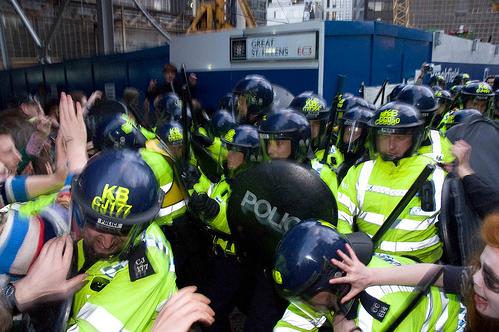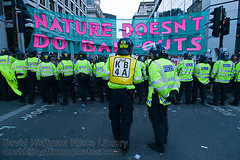
Via flickr user woo-war
The story of Ian Tomlinson’s death following an assault by a police officer during the G20 riots continues to develop: last night Channel 4 News found new footage providing additional context to the assault, while the Independent Police Complaints Commission announced that it will undertake the investigation into Tomlinson’s death itself – rather than (as initially planned) outsourcing it to the City of London Police, who were involved in policing protests on the day. Now, attention is focusing on the prospect of a criminal prosection. As former deputy assistant police commissioner Brian Paddick put it yesterday,
If it is held that there is a link between the violence he [the officer] was inflicting and the heart attack [suffered by Tomlinson], that then is an assault, resulting in death, albeit unintended. If a court held it is an assault, it is an unlawful action resulting in manslaughter.
But in focusing on whether the officer who beat Tomlinson and shoved him to the ground will be prosecuted, we risk losing sight of a bigger point – that this was far from an isolated incident.
To see why, read the following disturbing account of how the police cleared the “climate camp” on Bishopsgate that took place later that day. The account was written by a friend and colleague, Chris Abbott – the deputy director of the Oxford Research Group, and (ironically, in view of what happened) a leading expert on conflict resolution – in an email sent to me and others, and reproduced with his permission.
I went down to the climate camp after work on Wednesday as I had heard that it was completely peaceful and I wanted to see what it was like. Unfortunately, I got trapped there when the police first charged and then penned everyone in early in the evening and none of us could get out (this was about 7.00-7.30pm). Footage of this is now on YouTube. During this first, entirely unprovoked, attack I lost my girlfriend in the crowd – but I later found out she was punched by a policeman while trying to stop another girl being trampled on after being knocked to the floor.
Once that had calmed down, my girlfriend and I found each other and were sat with others in front of the line of riot police on the south side of Bishopsgate. It was completely peaceful once again and we were even joking and talking with the police. We were there for a couple of hours when they suddenly charged again without any warning (this was about 9.30-10.00pm). We were still sat down and offered no resistance at all. My girlfriend was pressure pointed on the neck (extremely painful), dragged backwards off me and had both her wrists bent behind her back by two policemen who threatened to break them. They dragged her outside the police cordon and then said “what should we do with her now?” before the other said “let’s throw her back in”, which they did – head first, with her hands behind her back. She landed on the floor and has now got severe bruising on her legs (which we have photos of) and very painful wrists (which we actually thought might be broken).
At the same time, I was punched full in the face by one of the policemen. I was on the floor and absolutely no threat, but he still punched me. I was pulled up and shoved towards the crowd as a group of policemen descended on me, several of them smashing me in the head repeatedly with the sides of their shields. The whole time I had my hands in the air and did not fight back at all, but that didn’t stop them. Luckily someone saw what was happening and managed to pull me free from the group of policemen just before they completely surrounded me and cut me off from everyone else. It frightens me to think what they might have done had I not been pulled free. My nose and the side of my head are still very painful, but I was lucky given the damage that they could have caused from hitting me in the head.
Immediately after it happened we saw that the girl we had been sat next to had also been injured and was going into shock. We tried to get her medical attention, but none of us were offered any assistance at all by the police.
Once we had calmed down and made sure everyone was alright, we went to the other end of the camp to try and get out because my girlfriend needed to get home and take medication that she requires. We spoke to a police medic to explain the situation, detailing the medication and why it was needed, but were told that they were under specific orders not to let anyone out even for medication. We continued to try and get the medic’s attention to explain the urgency of the situation, but he ignored us. By now things were getting very tense between the police and the crowd and my girlfriend got very panicky, falling to the ground. Only at this point did the police finally let us through the line to seek medical attention (this was about 11.30pm).
As Chris’s account shows, the officer who assaulted Tomlinson was not a solitary ‘bad apple’ – although the Met and the Home Office may well seek to present him as such, if a prosecution results from the IPCC investigation. On the contrary, the problem was systemic. As former Met Police assistant commissioner for special operations Andy Hayman wrote in the Times after mingling with both police and protestors on the day,
…the commissioner [of the Metropolitan Police] must ask serious questions about the style of policing. If left unchecked, we have a more violent crowd in uniform than the crowd demonstrating.
So while it’s right that the IPCC should concentrate for now on the circumstances of Tomlinson’s death, it’s also important to get underway with a broader inquiry – and a broader process of re-establishing confidence in the Met through re-establishing accountability. One question that such a process should look at is whether sufficient measures are in place to identify officers that overstep the line at these kinds of event – not by name, obviously, but by their number. There’s something strange and worrying in the fact that the IPCC should have said in its statement yesterday that,
At the moment the investigation is focused on identifying the officers in the footage. Several have already come forward and all efforts are being made to trace those who haven’t.
“Several have already come forward?” We’re not talking here about a bunch of kids thumping someone in the dead of night. We’re talking about the police, at a public event, with hundreds of cameras on them – and yet the Independent Police Complaints Commission is having to ask for help in identifying them.

This is absurd. The solution, surely, is that police riot uniforms should have individual officers’ numbers printed on them in letters large enough to be picked up on cameras – not just in small letters on the backs of their helmets. Officers in co-ordinating roles already have this (see photo – h/t Flickr user David Hoffman); it should become standard for all officers in public order contexts.
More fundamentally, we need to take a long, hard look at whether recent legislation on public order has created an enabling environment for this kind of policing. What has happened to civil liberties over the last decade is not a shining example of what one might have hoped for from a Labour government – whether you’re looking at the Terrorism Act 2000, the Serious Organised Crime and Police Act 2005, the Terrorism Act 2006, or the Racial and Religious Hatred Act 2006.
As policymakers in the UK, the US and elsewhere consign the term “war on terror” to the trash, it’s a good moment to ask whether we shouldn’t grab the chance to bin some of these Acts at the same time. (In considering this, staff at Number 10 might wish to reflect on the fact that Gordon Brown’s diplomatic success is now being overshadowed – all over the world – by stories about the summit’s policing: c.f. the New York Times, the Wall Street Journal, CNN, Die Welt, Le Monde, China Daily…)



